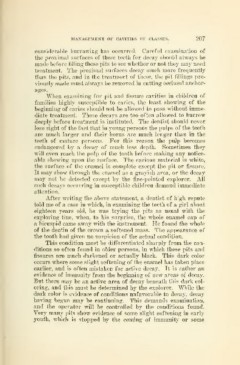Page 443 - My FlipBook
P. 443
MANAGEMENT OF CAVITIES BY CLASSES. 207
considerable burrowing has occurred. Careful examination of
the loroximal surfaces of these teeth for decay should always be
made before filling these pits to see whether or not they may need
treatment. The proximal surfaces decay much more frequently
than the pits, and in the treatment of these, the pit fillings pre-
viously made must always be removed in cutting occlusal anchor-
ages.
When examining for pit and fissure cavities in children of
families highly susceptible to caries, tl;e least showing of the
beginning of caries should not be allowed to pass without imme-
diate treatment. These decays are too often allowed to burrow
deeply before treatment is instituted. The dentist should never
lose sight of the fact that in young persons the pulps of the teeth
are much larger and their horns are much longer than in the
teeth of mature persons. For this reason the pulp becomes
endangered by a decay of much less depth. Sometimes they
will even reach the pulp of the tooth before making any notice-
able showing upon the surface. The carious material is white,
the surface of the enamel is complete except the pit or fissure.
It may show through the enamel as a grayish area, or the decay
may not be detected except by the fine-pointed explorer. All
such decays occurring in susceptible children demand immediate
attention.
After writing the above statement, a dentist of high repute
told me of a case in which, in examining the teeth of a girl about
eighteen years old, he was trying the pits as usual with the
exploring tine, when, to his surprise, the whole enamel cap of
a bicuspid came away with the instrument. He found the whole
of the dentin of the crown a softened mass. The appearance of
the tooth had given no suspicion of the actual condition.
This condition must be differentiated sharply from the con-
ditions so often found in older persons, in which these pits and
fissures are much darkened or actually black. This dark color
occurs where some slight softening of the enamel has taken place
earlier, and is often mistaken for active decay. It is rather an
evidence of immunity from the beginning of new areas of decay.
But there may be an active area of decay beneath this dark col-
oring, and this must be determined by the explorer. While the
dark color is evidence of conditions unfavorable to decay, decay
having begun may be continuing. This demands examination,
and the operator will be controlled by the conditions found.
Very many pits show evidence of some slight softening in early
youth, which is stopped by the coming of immunity or some


